
Did Man Descend from Adam or Apes?
|
|
The Biblical Answer:
 |
• Genesis 2:7 - The LORD God formed the man from the dust of the ground and breathed into his nostrils the breath of life, and the man became a living being.
• Genesis 2:21-23 - So the LORD God caused the man to fall into a deep sleep; and while he was sleeping, He took one of the man's ribs and closed up the place with flesh. Then the LORD God made a woman from the rib he had taken out of the man, and He brought her to the man. The man said, "This is now bone of my bones and flesh of my flesh; she shall be called 'woman, 'for she was taken out of man."
• 1 Corinthians 11:8-9 - For man did not come from woman, but woman from man; neither was man created for woman, but woman for man.
• Acts 17:26 - From one man he made every nation of men, that they should inhabit the whole earth; and He determined the times set for them and the exact places where they should live.
• Romans 5:12 - . . . sin entered the world through one man, and death through sin, and in this way death came to all men . . .
According to worldly philosophy, man came from an ape-like creature:
World Book Encyclopedia (1996):
 |
Time Magazine:
 |
|
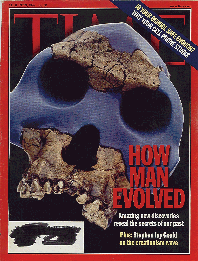 |
“The path from proto-apes to modern humans is commonly seen as a succession of new and improved species taking the place of worn out evolutionary clunkers. It’s a satisfying, if slightly chauvinistic tale, but experts in human evolution have known for years that it is dead wrong. . .” (Time Magazine, August 23, 1999, p.51)
Note that although Time Magazine is agreeing that the supposed evolution of man is not as simple as is commonly taught, they still believe that man evolved through a number of ape-like stages (see diagram above).
|
Problems with the Supposed Ape Man Series
• Scanty Evidence
• Artistic Liberty
• Mixing of Skeletal Parts from Different Sites
• Preconceived Bias
Examples of Scanty Evidence - Summarized from The Amazing Story of Creation by Dr. Duane Gish, 1990, pp.77-85
• Ramapithecus
 |
– Discovered in India in 1932
– Consisted of part of a fossilized jaw and a few teeth
– Some famous experts declared that these fossils proved that this creature was on its way to becoming human
– Later, enough of the creature was found to show that he was a orangutan
– The experts now admit that he was not an ancestor of man
• Orce Man
– Recently found in Spain near the village of Orce
– Consisted of a skull cap
– Was declared by Spanish experts to be the skull cap of the oldest fossil man ever discovered in Europe
– French experts later confirmed that the skull cap was that of a six-month-old donkey!
• Nebraska Man
 |
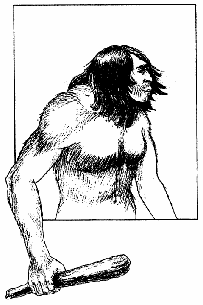 |
– Discovered in western Nebraska In 1922
– Consisted of a single tooth!
– Was shown to one of America’s foremost fossil experts, Dr. Henry Fairfield Osborn, professor at Columbia University.
– Dr. Osborn and other experts declared that the tooth had certain characteristics intermediate between ape and man
– It turned out to be the tooth of a pig!
Example of Artistic Liberty - Summarized from The Amazing Story of Creation by Dr. Duane Gish, 1990, pp.77-85
• Australopithecus boisei
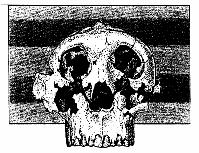 |
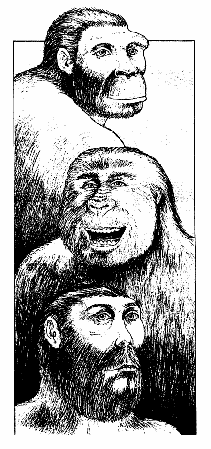 |
| Note: The three sketches on the right are artists' conception of what the possessor of the skull at the left would have looked like! |
– Reconstructions of what an “ape-man” might have looked like can vary greatly - depending on an artist’s viewpoint or belief system.
Examples of Mixing Skeletal Parts from Different Sites - Summarized from The Amazing Story of Creation by Dr. Duane Gish, 1990, pp.77-85
• Australopithecus robustus
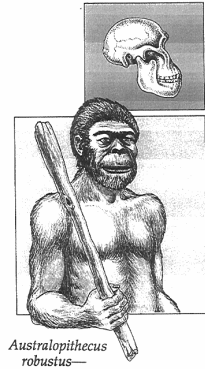 |
– Reconstructed head to toe on the basis of several craniums, more than a dozen jaws, and hundreds of teeth from two South African caves!
• Lucy (Australopithecus afarensis)
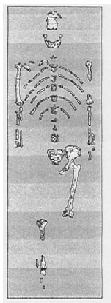 |
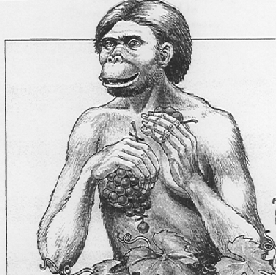 |
– In 1973, Dr. Donald Johanson, an American anthropologist, discovered the fossilized skeletal remains of a female Australopithecus in Ethiopia that he named “Lucy”.
– When they required a knee joint to prove that Lucy walked upright, they used one found more than 200 feet lower in the strata and more than two miles away!
Example of Preconceived Bias - Footprints in the Ashes of Time, Mary Leakey, National Geographic, April 1979 p. 446-457.
· The Laetoli Footprints - Summarized from Marvin Lubenow, Bones of Contention, 1992, p.173-175
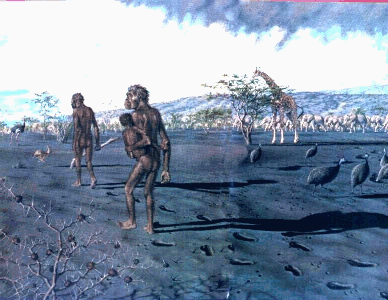 |
o In 1978, associates of Mary Leaky discovered what appear to be human footprint trails in northern Tanzania.
o Mary Leaky told the story in the April 1979 issue of National Geographic. She described the footprints as “remarkably similar to those of modern man.” And yet, according to evolutionary dating methods, the footprints were 3.5 million years old!
o Virtually everyone agrees that these footprints are strikingly like those made by modern humans. Yet, in spite of that fact, the evolutionist community has assumed that these are the footprints of an early “ape man” known as Australopithecus afarensis.
o Mary Leaky invited Russell H. Tuttle, a specialist from the University of Chicago, to investigate the footprints.
o Tuttle wrote an article describing the results of his findings in the March 1990 issue of Natural History magazine.
o Tuttle begins the article with this statement:
§ “The 3.5 million-year-old, humanlike footprint trails that Mary Leaky and her associates excavated at Laetoli, Tanzania, a decade ago rank among the great paleontological discoveries of our century.” (Natural History, March 1990, p.61)
§ After giving a report of his extensive investigation of these footprints, Tuttle gives the following conclusion at the end of the article:
§ “In sum, the 3.5 million-year-old footprint trails at Laetoli site G resemble those of habitually unshod modern humans. None of their features suggest that the Laetoli hominids [i.e. ape men] were less capable bipeds [i.e. walking upright] than we are. If the G footprints were not known to be so old, we would readily conclude they were made by a member of our own genus, Homo. Thus we are left with something of a mystery as to the Laetoli hominids . . . The Laetoli footprints hint that at least one other hominid roamed Africa about the same time.” (Natural History, March 1990, p. 64 - emphasis and brackets added)
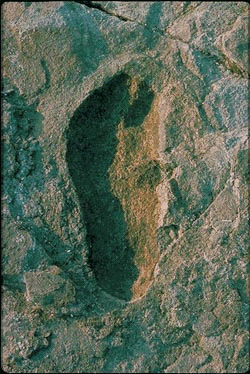 |
o “It is a classic case of interpreting the facts according to a preconceived philosophical bias.” (Lubenow, p.175)
Example of Preconceived Bias (Continued)
· The Kanapoi Elbow Fossil - Summarized from Marvin Lubenow, Bones of Contention, 1992, p.52-57
o In 1965, Bryan Patterson (Harvard University) discovered a fossil of the lower end (“elbow”) of an upper arm (humerus) bone in northern Kenya. This fossil is known as KP 271.
o According to evolutionary dating methods, this fossil is 4.5 million years old. Thus it is one of the oldest “ape man” fossil ever found (according to evolutionists).
o Patterson and W. Howells used extensive computer analysis to compare the KP 271 elbow with similar structures in:
§ A modern human
§ A chimpanzee, and
§ A fossil “ape man”: Australopithecus robustus.
o Patterson and W. Howells published the results of their findings in the April 7, 1967 issue of Science magazine.
o The results of Patterson and W. Howells’ tests indicated that the KP 271 elbow was “strikingly similar” to the modern human bone structure.
o And yet, Patterson and W. W. Howells suggested that the KP 271 elbow “might” belong to an Australopithecus!
o Why?
o Howells, writing fourteen years later, states that even though the KP 271 elbow “could not be distinguished” from a modern human elbow, because the idea of a modern human living 4.5 million years ago seemed “preposterous”, they suggested that the KP 271 elbow belonged to an Australopithecus instead!
Other Ape Men from the Evolutionary “Hall of Shame”
• Java Man
• Neanderthal Man
• Piltdown Man
Java Man - Summarized from Evolution: the fossils STILL say NO! by Dr. Duane Gish, 1995, pp. 280-281
· Dutch anatomist Dr. Dubois (1858-1940) went to the Dutch East Indies (now Indonesia) in search of the missing link between apes and humans.
· In 1891, along the banks of the Solo River in Java, Dubois found a skull cap that seemed to him to have a combination of human and ape features.
· A year later and 50 feet away from where he found the skull cap, Dubois found a thigh bone, very human in appearance, that he assumed belonged with the skull cap!
· Thus Dubois announced to the world that he had found a “missing link” between apes and humans.
· Thirty years later, Dubois admitted that he had also found two normal human skulls in the same area, thus casting doubt on the fact that he had truly found a “missing link”.
· A few years later, Dubois changed his mind about Java Man and declared that his find was nothing more than a giant ape (gibbon)!
Neanderthal Man - Summarized from The Amazing Story of Creation by Dr. Duane Gish, 1990, pp.77-85
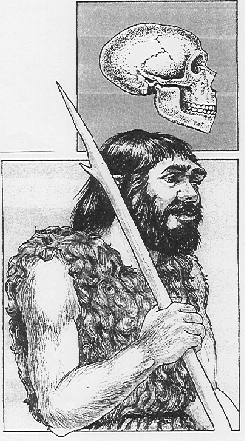 |
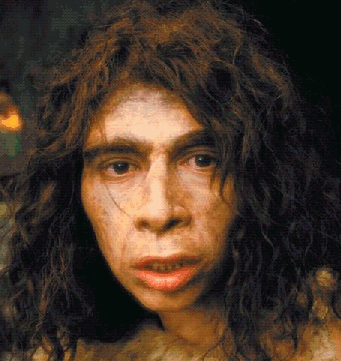 |
· The first few fossil fragments were found in Neanderthal Valley, in Germany In 1860
· Additional fossils were found in Europe, Asia, Africa, and Israel
· The Neanderthal people manufactured tools and weapons, and they buried their dead just like modern people
· Their brains are nearly the same size as modern day humans
· Their skulls were flatter than ours (causing them to appear “primitive”)
· Some of them had rather heavy eyebrow ridges (causing them to appear “primitive”)
· The skeleton in France appeared to be hunched over as if Neanderthal Man did not walk completely upright (causing it to appear “primitive”).
· Eventually scientists concluded that the so-called “primitive” features of Neanderthal people were due to disease (such as arthritis or rickets)
· About 30 years ago, two scientists published an article in which they declared that if Neanderthal Man were given a shave, a haircut, and a bath and put in a business suit - no one would know the difference between him and a regular human!
Piltdown Man - Summarized from The Amazing Story of Creation by Dr. Duane Gish, 1990, p.79
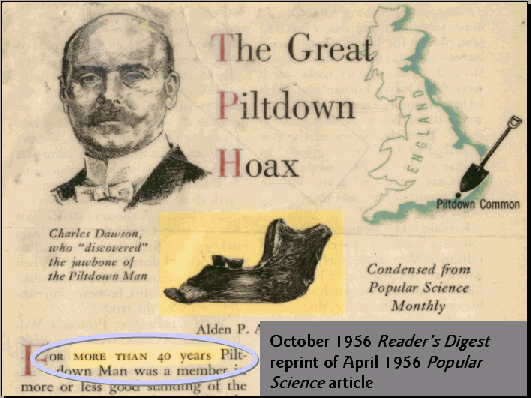 |
• In 1912, Charles Dawson, a lawyer and amateur fossil hunter, discovered a few fragments of a jawbone and pieces of a skull in a gravel pit near Piltdown, England.
• The jawbone appeared to be quite ape-like, but the teeth and skull appeared to be quite human-like.
• Dawson and the English scientists with whom he consulted declared that these fossils were from a creature intermediate between ape and man that existed 500,000 years ago.
• In 1925, Piltdown Man was used as one of the evidences of human evolution (from apes) in the famous Scopes Trial.
Piltdown Man - Used as Evidence in the Famous Scopes Trial - Quotations are from the testimony of Fay-Cooper Cole at the Scopes trial (1925) quoted in D-Day at Dayton, Jerry R. Tompkins, 1965, pp.169-173
 |
· “Anthropologists accept evolution as the most satisfactory explanation of the observed facts relating to the universe, to our world and all life on it . . . [The anthropologist works] side by side with the biologist and the geologist. For the study of man’s body . . . [the anthropologist] has selected a series of points for observation . . . these observations . . . are so definite that given a single skull or skeleton it is possible to tell with considerable certainty the age, sex and race of the individual . . .The skeletons tell much of man’s history . . . how he walked, how he held his head and many other details of his life. . .”
· Note: Anthropologists today still claim to know these kinds of details about an ancient person’s life merely by careful study of their skeleton!
o “When anthropologist Jerome Rose examines a human skeleton, the bones tell him a story of what that person’s life was like - where he lived, what he ate, how hard he worked . . . Rose says he develops a personal connection with the people whose bones he studies. ‘You get a connection you don’t get from reading about them or studying their trash .’”(Arkansas Democrat Gazette, March 17, 1999, p. 1B)
· “It does appear . . . that both man and other primates have a common [ancestor] . . .If this is true, then we might hope to find in ancient strata of the rocks some evidences of the earlier forms of men, who might more closely approach the common ancestor. This is exactly the case. . .[A find was made] near Piltdown in Sussex, England. This [find] consisted of the crushed skull of a woman and a jaw which can scarcely be distinguished from that of a chimpanzee. For a time there was much question if the two could possibly belong together, but a more recent find, which occurred about three miles [away] showed portions of the same type of skull and jaw. The skull is exceedingly thick and its capacity much less than that of a modern man, but is distinctly human, while as indicated, the jaw approaches that of an anthropoid [ape].”
In 1953, 28 years after the famous Scopes trial, Piltdown Man was shown to be a hoax! - Summarized from Reader’s Digest, “The Great Piltdown Hoax”, Alden P. Armagnac, 1956, pp.179-185
• As it turns out:
o The “fossil” bones had been planted in the gravel pit.
o The jawbone was from an ape.
o The skull was that of a modern human.
o The teeth had been filed to make them look human like instead of apelike.
o The bones had been treated with chemicals to make them look old.
• The Piltdown hoax fooled scientific “experts” for more than 40 years!
 |
See example below:
A Modern Hoax - Found in National Geographic, November, 1999
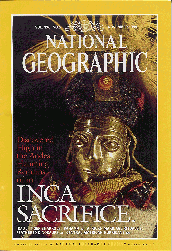 |
• In the November, 1999, National Geographic published a 10 page article with color pictures in which they stated that incontrovertible evidence had been found which proved that dinosaurs had evolved into birds! They wrote:
• “It’s a missing link between terrestrial dinosaurs and birds that could actually fly” (p.100)
• “We can now say that birds are theropods [a type of dinosaur] just as confidently as we say that humans are mammals” (p.105)
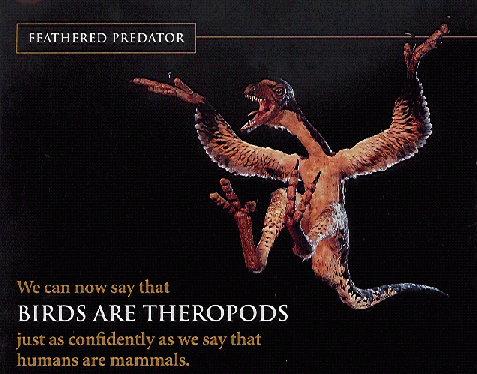 |
• “Then came the bad news. The discovery was phony. An opportunistic Chinese farmer, finding several sets of old bones in a shed, managed to rearrange them in such a manner that he was later able to persuade a buyer that one tail structure from some large but unidentifiable fowl belonged at the back end of an apparently legitimate dinosaur. That’s all it took to convince some pretty high powered scientists that this remarkable animal was once covered with feathers instead of scales, and that it had been airborne” (World, February 19, 2000 issue, p.18)
• In March, 2000, National Geographic published a retraction of its earlier article (in small print in the magazine’s obscure, had-to-find “Forum” section):
o “After observing a new feathered dromaeosaur . . . And comparing it with the fossil known as Archaeoraptor, I have concluded that Archaeoraptor is a composite . . . A dromaeosaur tail and a bird body [Letter from Xu Xing] . . . Xu Xing is one of the scientists who originally examined Archaeoraptor.”
A Creationist Response to the Evolutionary View of Human Origins - As Given by Marvin Lubenow in Bones of Contention, 1992
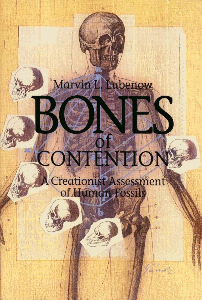 |
• Australopithecus - Evolutionary Date: 3.5 million years ago
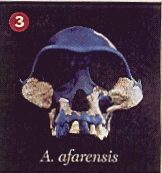 |
 |
• “Although brain organization is more important than brain size alone, the significant gap between the cranial capacities of the largest australopithecine and the smallest human, fossil or living, has not been bridged.” (p.168)
• “Humans appeared in the fossil record before the australopithecines and lived as contemporaries with them throughout their history.” (p.166)
• “The australopithecines are simply extinct primates.” (p.166)
• Additional Notes - Summarized from The Amazing Story of Creation by Dr. Duane Gish, 1990, pp.77-85
• Dr. Solly Zuckerman, a famous British anatomist, and a team of scientists studied the fossils of Australopithecus for 15 years using the most sophisticated methods of anatomical study available.
• After many years of study, Zuckerman and his team concluded that Australopithecus was merely a type of extinct ape.
• Dr. Charles Oxnard, former Professor of Anatomy and Director of Graduate Studies at the University of Southern California Medical School, studied the Australopithecus for many years using the latest techniques for his research.
• Oxnard, even though he is not a creationist, has declared that these creatures:
• Did not walk upright
• Were not ancestors of man
• Homo habilis - Evolutionary Date: 2 million years ago
 |
 |
• “We have strong evidence that the category known as Homo habilis is not a legitimate taxon [classification] but is composed of a mixture of material from at least two separate taxa, one large and one small.” (p.165)
• Homo erectus - Evolutionary Date: 1.8 million years ago
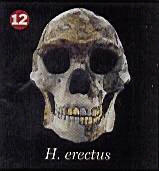 |
 |
• “A number of evolutionists have expressed the fact that Homo erectus, while a bit different, is not so different from modern humans as to warrant a separate species designation.” (p.134-135)
• “All of the evidences that one could reasonably expect to be discovered to demonstrate the full humanity of Homo erectus have already been found in association with him.” (p.140)
• Homo erectus sites show:
• Controlled use of fire
• Stone Tools
• Evidence of burial and cremation
• Archaic Homo sapiens - Evolutionary Date: 700,000 years ago
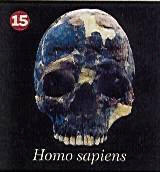 |
 |
• “Rhodesian Man, probably the best known of all of the archaic Homo sapiens was either mining lead and zinc himself or was in the mine shaft at a time when lead and zinc were being mined by other humans. This smacks of a rather high degree of civilization and technology.” (p.83-85)
• Genesis 4:22 - Tubal-Cain . . . forged all kinds of tools out of bronze and iron.
• Job 28:1-4, 9-10 - "There is a mine for silver and a place where gold is refined. Iron is taken from the earth, and copper is smelted from ore. Man puts an end to the darkness; he searches the farthest recesses for ore in the blackest darkness. Far from where people dwell he cuts a shaft, in places forgotten by the foot of man; far from men he dangles and sways. Man's hand assaults the flinty rock and lays bare the roots of the mountains. He tunnels through the rock; his eyes see all its treasures.
• Modern Humans - Evolutionary Date: 100,000 years ago
 |
• “There are fossils that are indistinguishable from modern humans that extend all the way back to 4.5 million years on the evolutionary time scale.” (p.169)
• “As far back as the human fossil record goes the human body has remained substantially the same and has not evolved from something else.” (p.140)
Chart of Ape/Man Fossil Evidence - As Given by Marvin Lubenow in Bones of Contention, 1992, p.171
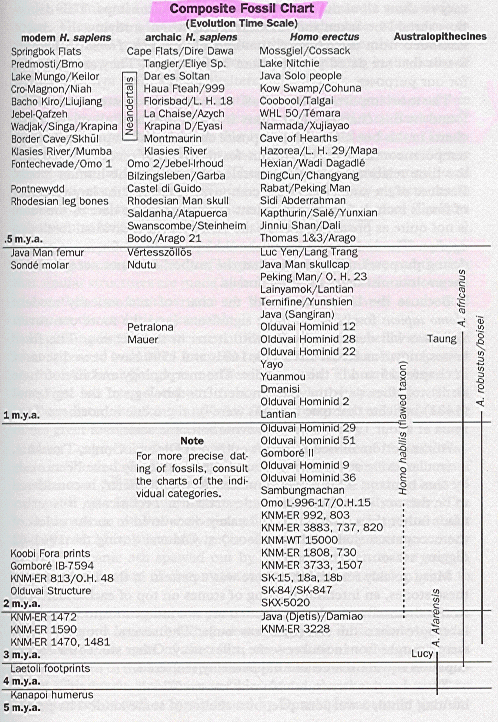 |
The Bottom Line
• An ancient (or modern) man is still a man – even if he happens to have some “ape-like” characteristics:
– Hairy
– Stooped Over
– Long Arms
– Ape-like skull features:
• Low Forehead
• Heavy Brow Ridges
• Lower Skull Capacity
• Thicker Skull
• The thing that sets man apart from an ape (or any other animal) is that he is “made in the image of God”.
• This shows up in such things as:
– The ability to communicate using language
– The ability to develop and use technology
– An awareness of God (or gods) exhibited in some form of worship
– An awareness of the eternal significance of human life exhibited in such things as burial
Man is NOT Just Another Kind of Animal
“Most eight-year-olds can write an understandable letter to their grandparents describing a trip to the zoo, or can move to a foreign country and learn any other language in the world, and we think it entirely normal. But no animal will ever write such a letter to its grandparents, or give the past, present, and future of even one French verb, or read a detective story and understand it, or understand the meaning of even one verse from the Bible. Human children do all these things quite readily, and in so doing they show themselves so far superior to the whole animal kingdom that we wonder why people have sometimes thought that we are merely another kind of animal.” (Wayne Grudem, Systematic Theology, pp. 446-447)